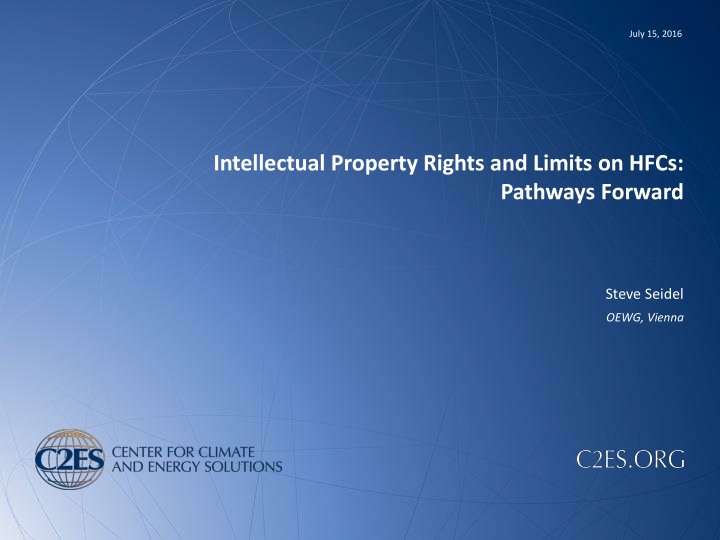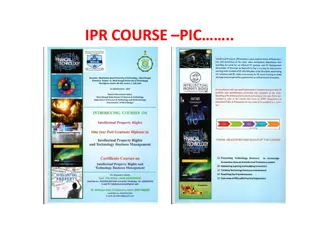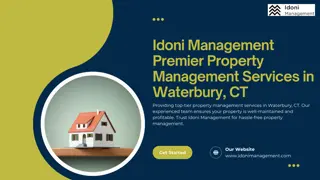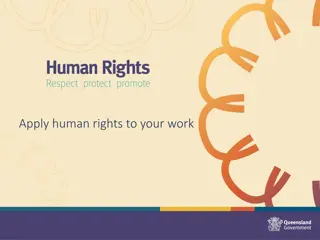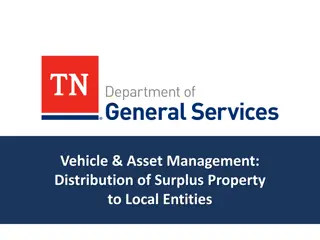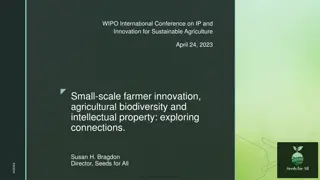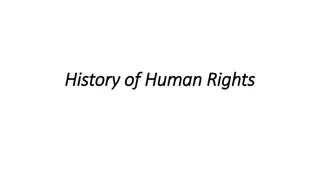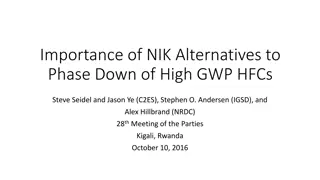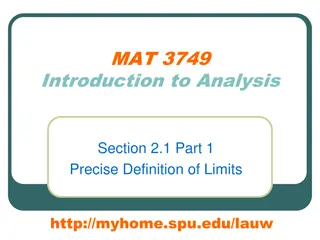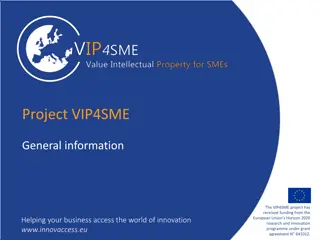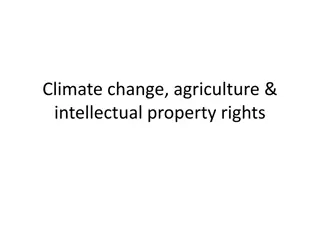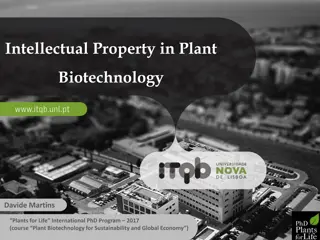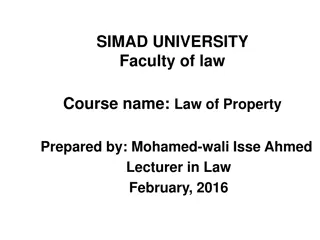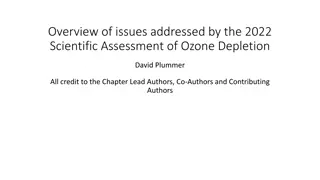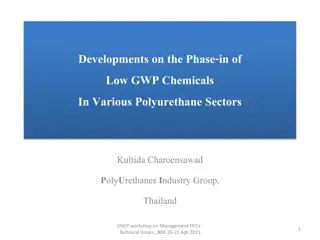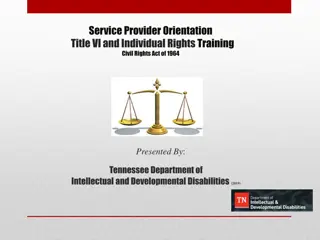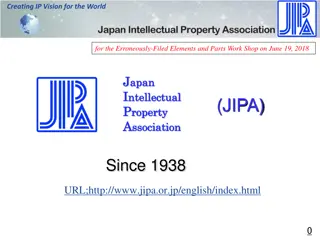Intellectual Property Rights and Limits on HFCs: Pathways Forward
This content delves into the challenges associated with intellectual property rights (IPR) in the context of HFCs, focusing on concerns like patents on substitutes, competitive disadvantages for chemical producers, and availability of low-GWP alternatives. It explores potential solutions such as the role of the Multilateral Fund, standard commercial arrangements, expiration dates for key patents, and legal challenges. The basics of IPR, including patent principles and their historical significance in the industry, are also discussed.
Download Presentation

Please find below an Image/Link to download the presentation.
The content on the website is provided AS IS for your information and personal use only. It may not be sold, licensed, or shared on other websites without obtaining consent from the author.If you encounter any issues during the download, it is possible that the publisher has removed the file from their server.
You are allowed to download the files provided on this website for personal or commercial use, subject to the condition that they are used lawfully. All files are the property of their respective owners.
The content on the website is provided AS IS for your information and personal use only. It may not be sold, licensed, or shared on other websites without obtaining consent from the author.
E N D
Presentation Transcript
July 15, 2016 Intellectual Property Rights and Limits on HFCs: Pathways Forward Steve Seidel OEWG, Vienna
Background Center for Climate and Energy Solutions An independent, nonpartisan, nonprofit organization working to advance strong policy and action to address our climate and energy challenges. Launched in 2011, C2ES is the successor to the Pew Center on Global Climate Change, long recognized in the United States and abroad as an influential and pragmatic voice on climate issues. Intellectual Property Rights: OEWG, Vienna 2
IPR Raises Significant Concerns With large number of patents on substitutes held by transnational chemical companies Will chemical producers in Article 5 Parties be at a competitive disadvantage or locked out of markets? If able to produce substitutes, will application patents prevent Article 5 chemical producers from selling into domestic and global markets? Will low-GWP alternatives be available in adequate quantities, at reasonable prices, and from multiple suppliers? CAUTION: Not an IP attorney. Research is a work in progress. Intellectual Property Rights: OEWG, Vienna 3
Overview Four possible pathways/solutions to address these concerns: Role of the Multilateral Fund in paying for patents and licensing fees Standard commercial arrangements (licensing, joint ventures) Expiration dates for some key patents Legal challenges to some key patents All could play a role going forward But first a few basics about IPR Intellectual Property Rights: OEWG, Vienna 4
IPR Basics Patents seek to balance goals both of rewarding and advancing innovation. Time-limited exclusivity in return for making innovative information public Only applicable in country where patent filed vast majority of Article 5 Parties not directly impacted Expire after 20 years, but when clock starts ticking is critical Not new or unique to fluorocarbons, but number of patents have increased Patents and royalties an issue in 1990 when Protocol s MLF established Patents in three areas relevant here Production process patents (to make HFO-1234yf) Composition and use/application patents (to use yf in mobile AC) Equipment patents (design of compressor or other ac component) Intellectual Property Rights: OEWG, Vienna 5
Solutions: Multilateral Fund (MLF) Pays for Patents or Licensing Indicative list of categories of incremental costs guides what the MLF pays for Includes cost of patents and design and incremental costs of royalties for Converting existing production facilities Establishing new production facilities Use in manufacturing as an intermediate good (e.g., refrigerators, foam, aerosols) General principles also guide funding decisions Most cost-effective and efficient option taking into account industrial strategy of recipient Party (cost-effectiveness thresholds) Avoid double counting, limits on payments of operational costs Intellectual Property Rights: OEWG, Vienna 6
Past Experience under MLF To what extent have patents been paid for by MLF? Several areas where patents and licensing fees played a role: Technology sector guidelines developed by the Executive Committee Small number of investment projects where fees explicitly paid Vast majority of projects either patent costs embedded in technology costs or technology not covered by patent Intellectual Property Rights: OEWG, Vienna 7
Why Patents Paid for In So few Projects? Many alternative technologies in the public domain Never subject to a patent or patent had expired MLF focus on proven, widely available, cost-effective technologies Some cases of patents voluntarily made available for use Significant shift to not-in-kind alternatives (NIKs) Could be more cases where patent costs are incurred Depends on timing of investments (compared to expiration of patents) and role of NIKs Intellectual Property Rights: OEWG, Vienna 8
Solutions: Commercial Arrangements among Producers Fluorocarbon producers in Article 5 Parties can: Develop unique production processes (but application patents must still be addressed) Enter into commercial agreements with patent holder License to produce and sell Joint venture partnerships Supply agreements Wait for patents to expire and then produce and sell Intellectual Property Rights: OEWG, Vienna 9
Solutions: Commercial Agreements Several HFO-1234yf supply agreements have been reached 3F Zhonghao (China) with Chemours Juhua (China) with Honeywell Navin (India) with Honeywell SRF (India) has announced its own pilot plant Intellectual Property Rights: OEWG, Vienna 10
Solutions: Patent Expiration Dates COMPOSITION CONTAINING FLUORINE SUBSTITUTED OLEFINS Invention Title Publication Number 50/2015 Publication Date 2015/12/11 Publication Type INA Application Number 4952/DELNP/2015 Application Filing Date 2015/06/09 Priority Number U.S.A.60/693,853,U.S.A.11/475,605 Priority Country U.S.A.,U.S.A. Priority Date 2005/06/24, 2006/06/26, Intellectual Property Rights: OEWG, Vienna 11
Solutions: Wait for Patents to Expire Patents expire 20 year after date of PCT filing or related patent claimed as priority Patents below are under legal challenge, but if challenges are NOT successful Expiration Dates for Some Key YF Patents for Use in Auto AC US 7,279,451 7,534,366 8,033,120 8,065,882 9,157,017 2023 2023 2023 2023 (filed 2009) 2023 (filed 2014) EP 1 563 032 1 716 216 1 725 628 2023 2025 (revoked) 2024 IN 250569 239049 2025 (filed 2006) 2023 (filed 2005) Intellectual Property Rights: OEWG, Vienna 12
Solutions: Legal Challenges Examined legal challenges to application patents for use of HFO- 1234yf in auto ac. 9 patents in US (4), EU (3) and Japan (2) all patent-holder claims relevant to HFO-1234yf in auto ac have been rejected. Basis for rejections vary but include: Lack of novelty or inventiveness due to prior art Failure to describe in the application a basis for the claims added by amendment (i.e. an added matter issue). Appeals have been exhausted in 2 of these cases; further appeals are pending in the remaining 7. Patents remain in effect pending final appeals Paper available at: http://www.c2es.org/docUploads/status-of- legal-challenges-07-2016.pdf Intellectual Property Rights: OEWG, Vienna 13
Solutions: Legal Challenges A newly granted patent in the US (9,157,017) has been challenged (but 2023 expiration date) and the EPO has stated its intention to grant two new relevant divisional patents. Additional patents remain a possibility Review of claims in relevant patents in India and China found that the same or similar patent-holder claims have been rejected in the US, Japan and Europe. The European Commission has issued a Statement of Objections to Honeywell and DuPont regarding antitrust concerns with their cooperation on production of HFO-1234yf, a refrigerant for use in auto ac. Intellectual Property Rights: OEWG, Vienna 14
Solutions: Legal Challenges Patent Number Initial Appeal Further Appeals Current Status US 7,534,366 PTO reexamination all claims rejected PTAB affirmed rejections Appealed to US Ct of Appeals US 7,279,451 PTO reexamination all claims rejected PTAB affirmed rejections; issued new rejections Rehearing by PTAB requested US 8,033,120 PTO reexamination all claims rejected PTAB affirmed rejections; issued new rejections Rehearing by PTAB requested; prosecution re- opened US 8,065,882 PTO reexamination all claims rejected PTAB affirmed rejections; issued new rejections Rehearing by PTAB requested; prosecution re- opened EP 1 563 032 EPO Opposition Division revoked patent Under appeal to EPO Board of Appeal Appeal of revocations is pending EP 1 716 216 EPO Opposition Division revoked patent Decision by EPO Opposition Division upheld on appeal No further appeals possible EP 1 725 628 EPO Opposition Division revoked patent Under appeal to EPO Board of Appeal Appeal of revocation is pending JP 4699758 JPO Board of Appeals invalidated patent Appeals court affirmed invalidation Revocation is final JP 4571183 JPO Board of Appeals invalidated patent Appeal to high court pending Appeal pending Intellectual Property Rights: OEWG, Vienna 15
Key Take Aways Patents have been raised as an important issue in achieving an HFC phasedown Four potential pathways/solutions exist for addressing concerns: Multilateral Fund includes licensing and royalties in its list of eligible costs and could pay for licensing Commercial agreements are emerging among chemical producers Some key patents will expire in the 2023-2025 timeframe Legal challenges are successfully invalidating some of the key patents, but more are issuing Also keep in mind Phase down can be sequenced with sectors with low-cost alternatives moving first NIK alternatives provide alternatives to HFOs for many sectors Intellectual Property Rights: OEWG, Vienna 16
Production of Alternatives: Prices Past concerns that HFC-134a prices would be 3-8 times that of CFCs it replaced. Actual prices roughly 2 times that of CFCs ($7.00kg v. $3.30 kg for CFCs adjusted to current dollars) Increased production capacity, improved production processes and competition from not-in- kind alternatives all limited price increases $30 $25 $20 $15 $10 $5 $0 Initial cost of CFCs Estimated price Actual Price increase Intellectual Property Rights: OEWG, Vienna 18
Production of Alternatives: Where and When HFC-134a production started in non-A5 Parties and now half or more located in A5 Parties Intellectual Property Rights: OEWG, Vienna 19
Evolution of Fluorocarbon Production in india Fluorocarbon chemical producers in India CFC/HCFCs HFCs HFOs Chemplast Sanmar Gujarat Fluorocarbons Hindustan Fluorocarbons 32 (exploring converting 22 plant) Gujarat Fluroocarbons (supplier to HON) Navin Fluorine (pilot) SRF Limited 134a 32 (swing capacity with 134a) Intellectual Property Rights: OEWG, Vienna 20
